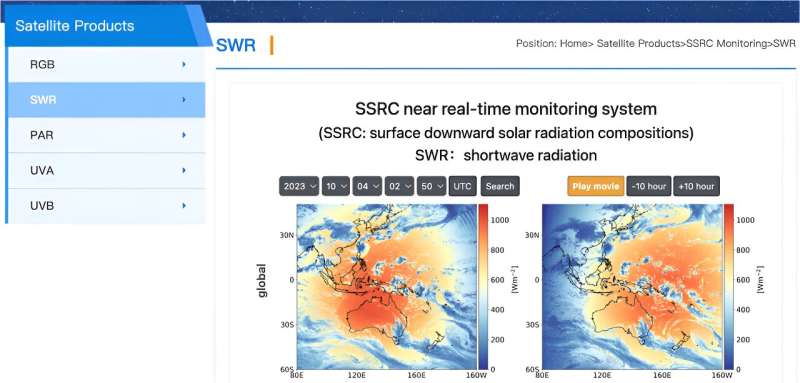Scientists unveil high-resolution remote sensing monitoring system for surface solar radiation
Solar radiation reaching the Earth’s surface serves as the cornerstone of our planet’s energy dynamics, driving climate patterns, sustaining life through photosynthesis, and powering renewable energy technologies. The presence of clouds and aerosols significantly impacts surface solar radiation. Scientists have tackled both theoretical and technical challenges in measuring the scattering of light caused by various atmospheric clouds and aerosol particles.
A near real-time remote sensing monitoring system for surface solar radiation was unveiled on November 30, by scientists from the Aerospace Information Research Institute (AIR) of the Chinese Academy of Sciences (CAS), marking their endeavor to establish the most precise surface solar radiation monitoring system in the country. This system and its associated data products are currently accessible on the website.
The findings were published in the Bulletin of the American Meteorological Society.
The system, with its monitoring scope of solar radiation covering the Asia-Pacific region, has utilized the observation data from China’s Fengyun-4 and Japan’s Himawari 8/9 geostationary meteorological satellites. It leverages a combination of physical-based radiative transfer models and artificial intelligence techniques, in addition to the consideration of other impact factors such as the atmospheric gas absorption and surface reflection in ice and snow-covered regions.
The system provides 12 data products including shortwave radiation, photosynthetically active radiation, ultraviolet-A radiation, ultraviolet-B radiation, as well as the global, direct, and diffused components for each radiation composition. The data products have achieved significant improvement in both spatio-temporal resolution and accuracy, especially in monitoring rapid changes in solar radiation under clouds and in regions covered with ice and snow such as the Qinghai-Tibet Plateau.
The resulting data products feature spatial resolutions ranging from 1 to 5 kilometers and temporal resolutions of 10 to 15 minutes, thereby realizing high-resolution, high-frequency, fine, and near-real-time surface solar radiation monitoring capabilities. The data is set to illuminate the magnitude and dispersion of surface solar radiation.
“Thanks to the advances in satellite remote sensing technology, particularly the next-generation geostationary satellites represented by China’s Fengyun-4, opportunities for the fine and near-real-time monitoring of surface solar radiation have emerged,” said Prof. Husi Letu from AIR.
“The newly released surface solar radiation products are quite different from the traditional ones as they address the issues of inadequate spatiotemporal resolution, lack of information on solar radiation compositions, and challenges in distinguishing between direct and diffused components.”
More information:
Husi Letu et al, Surface Solar Radiation Compositions Observed from Himawari-8/9 and Fengyun-4 Series, Bulletin of the American Meteorological Society (2023). DOI: 10.1175/BAMS-D-22-0154.1
Citation:
Scientists unveil high-resolution remote sensing monitoring system for surface solar radiation (2023, December 8)
retrieved 8 December 2023
from https://phys.org/news/2023-12-scientists-unveil-high-resolution-remote-surface.html
This document is subject to copyright. Apart from any fair dealing for the purpose of private study or research, no
part may be reproduced without the written permission. The content is provided for information purposes only.

Solar radiation reaching the Earth’s surface serves as the cornerstone of our planet’s energy dynamics, driving climate patterns, sustaining life through photosynthesis, and powering renewable energy technologies. The presence of clouds and aerosols significantly impacts surface solar radiation. Scientists have tackled both theoretical and technical challenges in measuring the scattering of light caused by various atmospheric clouds and aerosol particles.
A near real-time remote sensing monitoring system for surface solar radiation was unveiled on November 30, by scientists from the Aerospace Information Research Institute (AIR) of the Chinese Academy of Sciences (CAS), marking their endeavor to establish the most precise surface solar radiation monitoring system in the country. This system and its associated data products are currently accessible on the website.
The findings were published in the Bulletin of the American Meteorological Society.
The system, with its monitoring scope of solar radiation covering the Asia-Pacific region, has utilized the observation data from China’s Fengyun-4 and Japan’s Himawari 8/9 geostationary meteorological satellites. It leverages a combination of physical-based radiative transfer models and artificial intelligence techniques, in addition to the consideration of other impact factors such as the atmospheric gas absorption and surface reflection in ice and snow-covered regions.
The system provides 12 data products including shortwave radiation, photosynthetically active radiation, ultraviolet-A radiation, ultraviolet-B radiation, as well as the global, direct, and diffused components for each radiation composition. The data products have achieved significant improvement in both spatio-temporal resolution and accuracy, especially in monitoring rapid changes in solar radiation under clouds and in regions covered with ice and snow such as the Qinghai-Tibet Plateau.
The resulting data products feature spatial resolutions ranging from 1 to 5 kilometers and temporal resolutions of 10 to 15 minutes, thereby realizing high-resolution, high-frequency, fine, and near-real-time surface solar radiation monitoring capabilities. The data is set to illuminate the magnitude and dispersion of surface solar radiation.
“Thanks to the advances in satellite remote sensing technology, particularly the next-generation geostationary satellites represented by China’s Fengyun-4, opportunities for the fine and near-real-time monitoring of surface solar radiation have emerged,” said Prof. Husi Letu from AIR.
“The newly released surface solar radiation products are quite different from the traditional ones as they address the issues of inadequate spatiotemporal resolution, lack of information on solar radiation compositions, and challenges in distinguishing between direct and diffused components.”
More information:
Husi Letu et al, Surface Solar Radiation Compositions Observed from Himawari-8/9 and Fengyun-4 Series, Bulletin of the American Meteorological Society (2023). DOI: 10.1175/BAMS-D-22-0154.1
Citation:
Scientists unveil high-resolution remote sensing monitoring system for surface solar radiation (2023, December 8)
retrieved 8 December 2023
from https://phys.org/news/2023-12-scientists-unveil-high-resolution-remote-surface.html
This document is subject to copyright. Apart from any fair dealing for the purpose of private study or research, no
part may be reproduced without the written permission. The content is provided for information purposes only.
